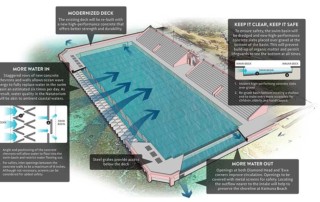New Concept Design Unveiled for Waikiki War Memorial Natatorium
The National Trust for Historic Preservation contributes concept proposal in efforts to rehabilitate a one-of-a-kind war memorial to the men and women of Hawaii Swim Basin Rehabilitation Concept for Waikiki Natatorium War Memorial (Design: Dr. Hans Krock) On Veterans’ Day 2016, the National Trust for Historic Preservation unveiled its proposal for revitalizing the Waikiki War Memorial Natatorium —one of the most unique structures in the country commemorating those who served and gave their lives in World War I. The rehabilitation concept, designed by Hawaii’s globally-renowned engineer Dr. Hans Krock, is a simple, innovative and long-term solution that would ensure a clean and safe swim basin for the endangered memorial. “This concept proposal is part of our ongoing commitment to develop a collaborative preservation plan that once again allows the Natatorium to operate as a vibrant aquatic facility, community resource and ‘living memorial’ to be enjoyed by future generations,” said Barbara Pahl, senior vice president of field services for the National Trust. “We’re excited to contribute an environmentally responsible alternative—protecting public health and safety—and encourage the City and County of Honolulu and Hawaii locals to take a close look at the design and the opportunity to restore one of the state’s most recognizable historic sites.” The National Trust’s concept proposal for the Natatorium is the result of a collaborative effort with local experts and preservationists, which began with the site’s National Treasures designation in May 2014. The concept, developed by Dr. Hans Krock, Emeritus Professor of Ocean and Resources Engineering at the University of Hawaii at Manoa, and Dr. Alfred Yee, foremost authority in the design of concrete structures and consulting engineer for Pearl Harbor’s USS Arizona Memorial, addresses [...]




